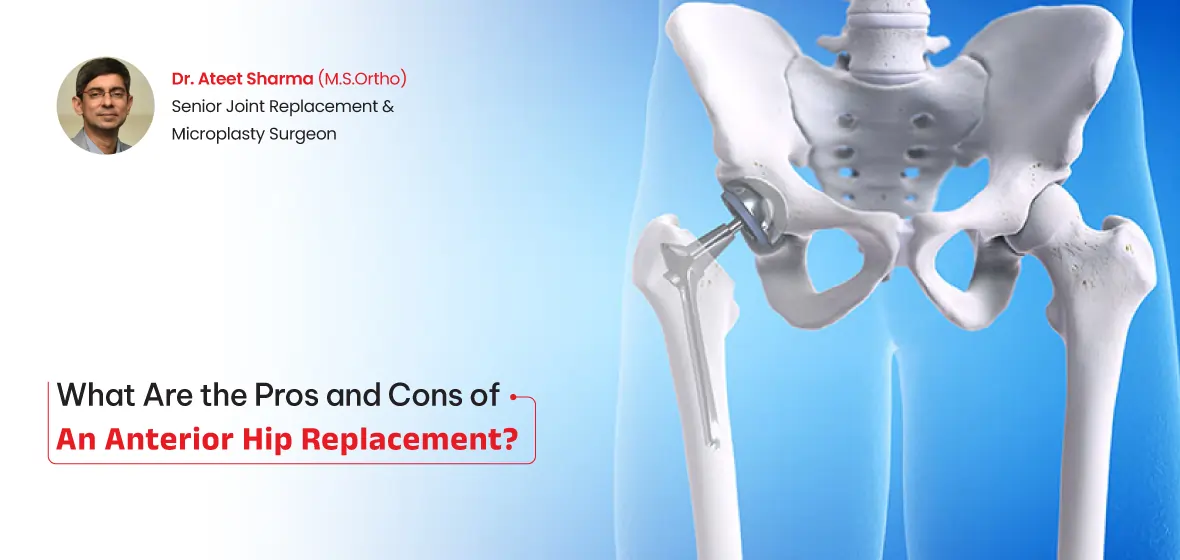
It is so fun to enjoy life to its fullest. But what if continuous pain in your hip is the reason for your slowdown?
After a visit to your doctor, you are advised about an option that can lead you back to your routine. Hip Replacement is one of the leading treatments that can relieve pain and get an individual back to a routine. Here, with the help of the best surgeon, Dr Ateet Sharma, who has been performing successful Hip Replacement Treatment in Ahmedabad, we will learn in detail about the Advantages And Disadvantages of Anterior Hip Replacement.

Traditional Hip Replacement is performed from two approaches, i.e., back or side, also called posterior or lateral approaches. On the other hand, Anterior Hip replacement is approached from the front. The main difference between the two types is the location of the approach being taken place. It offers some advantages over the traditional method. Thus, we are here to explore the Pros and Cons of an Anterior Hip Replacement in a brief so that you can make a wise decision.
Anterior Hip Replacement is a modern technique that is gaining popularity nowadays. Compared to the traditional hip replacement, an anterior hip replacement involves less damage to the muscles and the soft tissue surrounding it.
Here is a list of points why you should go for an Anterior Hip Replacement
One of the primary advantages of Anterior Hip Replacement is that it avoids cutting major muscles of the affected part. When approached through the side or back, it leads to major damage, whereas when approached from the front, there are fewer muscles.
Here, the surgeon works between fewer muscles rather than cutting through muscle fibres or detaching muscles from bones. The less destruction of muscle ultimately leads to a faster recovery process.
As the Anterior approach involves minor cutting requirements of the muscles, the experience of the patients becomes sooth after the surgery. Less amount of damage leads to reduced pain for an individual, which ultimately reduces the requirement for pain medicines. Overall, the Anterior Hip Replacement approach helps in a comfortable and quicker recovery period.
After the surgery, it is essential to maintain proper care for a quick and healthy recovery. To maintain a speedy recovery, make sure to take some time off from work and maintain a durable rest for a faster recovery. Along with resting, follow your surgeon's prescribed pain management plan. The anterior approach has a better recovery than the Traditional Hip Replacement Recovery time.
After you undergo Anterior Hip Replacements, you can stop using walkers or other assistive devices 5 to 7 days sooner than those who have traditional hip surgery.
The procedure of an Anterior Hip Replacement is done when the patient is lying on their back instead of their side. In this kind of situation, an X-ray called fluoroscopy can be used to provide better precision. Better placement can minimise the chances of the artificial joint wearing out over time. Thus, the overall level of precision is increased in this treatment.
After you have undergone a Hip Replacement, the patient will receive a list of precautions for the management of specific movements and activities to avoid any other condition of further risk of a new hip from dislocating.
With the anterior approach, surgeons often assign fewer or no post-surgical precautions. It helps in creating a more convenient environment and a less restrictive one.
However, it is important to note that the advantage may differ according to different conditions of an individual, like the signs that you require a hip replacement or the severity of the issue. Some surgeons performing the traditional approach may also minimise post-operative precautions.
There are two sides to a coin. Now, as we have seen the advantages, let us move towards the other side and understand the Disadvantages of Anterior Hip Replacement.
There might be a minor complication of temporary numbness in the thigh during the Anterior Hip Replacement. The cause of this numbness is the stunning of the lateral femoral cutaneous nerve (LFCN). The function of LFCN is to provide sensation to the skin of the thigh.
While the surgery is going on, this nerve is pushed aside to allow the proceeding of the procedure. This minor numbness usually resolves within a month or two.
Limb Length Discrepancy is a condition when there is a noticeable difference in the lengths of the legs after surgery. It is a complication that might occur with any hip replacement procedure, including the anterior approach.
It sounds risky, right?
But, no worries, the reality is far better than what this sounds.
To minimise this risk of LLD, our surgeon, Dr Ateet Sharma, uses X-rays or robot-assisted techniques during Anterior Hip Replacement. This method ensures an accurate leg length assessment and adjustment. Additionally, the anterior approach makes it easier to assist the leg length during the procedure as the patient lies on their back.
It sounds risky, right?
When we talk about surgery, scars are automatically a part of it. Anterior Hip Replacement also results in a surgical scar. But, as this is a part of the process, some scars will be there.Scars are a common part of any surgery. But these prevention measure helps in preventing any future uncertainties.
Finally, we have understood both sides of anterior hip replacement. Now, it will be easier for you to decide which treatment should be preferred for your condition. Overall, along with numerous advantages and few complications, our Robotic Joint Replacement Surgeon, Dr Ateet Sharma, has deep expertise in bringing the best of advantages and eliminating almost all disadvantages while performing hip replacement treatment in Ahmedabad.
© 2025 Dr.Ateet Sharma All rights reserved. | Manage by Nexus